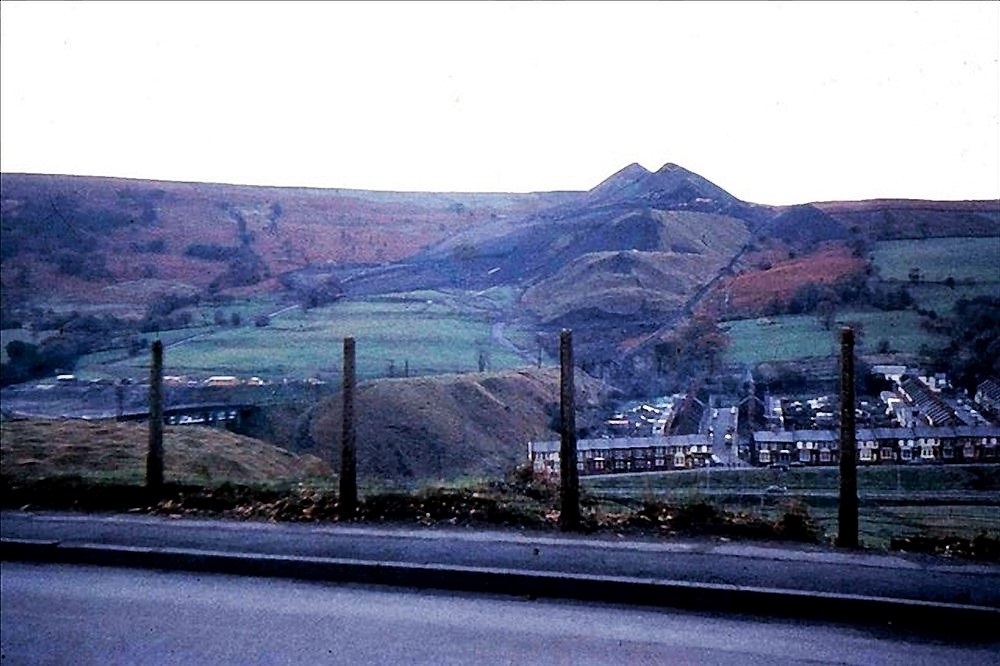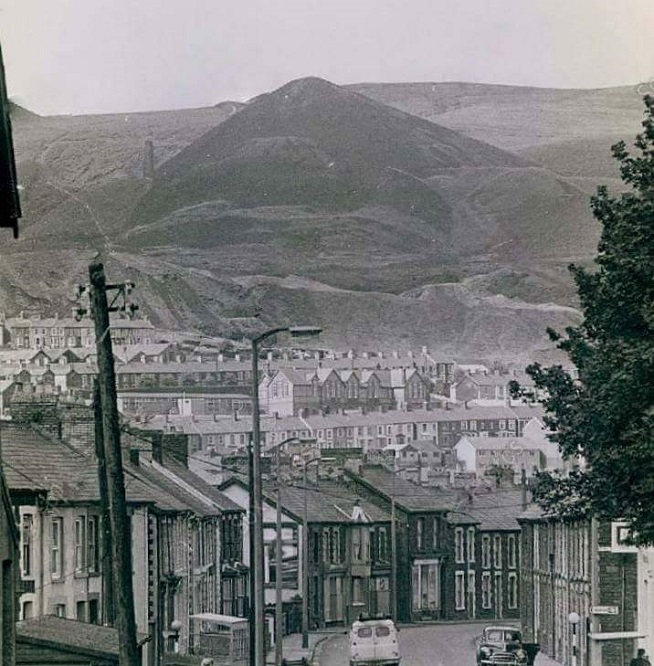Black Tips and Pyramids

In a special article to mark the anniversary this week of the Aberfan Disaster, John Geraint, one of Wales’s most experienced documentary-makers, reflects on living under the shadow of the coal tips and the aftermath of the tragedy.
John Geraint
It was a helicopter we went up in – me and the camera crew, and Jason Mohammad, the presenter of the TV series we were making about life amongst the world’s highest mountains.
Up we flew, up above the trendy ski resort of Zermatt, up and up again, until there was nothing to see but the elemental grandeur of 4000-metre-high snow-capped Alps, and the age-old Gorner Glacier beneath them, frozen even in high summer.
And when I spotted it, in the distance – the distinctive shape of the Matterhorn, a massive pyramid dominating the horizon – it was then that I turned to the pilot and told him something he couldn’t possibly have understood: “Duw!” I said, “It’s just like the Rhondda!”
What on earth did I mean? Comparing the Swiss Alps to the Rhondda: had I gone crazy? Well, I must admit, I was a bit light-headed. The altitude. That dizzy ride in the chopper. All those mountain vistas – vast, majestic, breath-taking.
But there was some logic in my madness, if I say so myself.
I’d like to explain it properly; but first, let me tell you a bit more about why we were flying so high, and about the daredevil we were going to interview.
Sam Anthamatten is a star of free-skiing. It’s the ultimate modern sport: an extreme contest between man and mountain.
We had spectacular hi-definition footage, filmed from helicopters and drones, of Sam skiing at maximum velocity, off-piste, on the brink of impossible mountain edges and Alpine cornices, leaping off precipices to land on pristine snow with no waymarks, and then hurtling on down, down, down, testing to the utmost how steep a skiing line can get before it becomes an uncontrollable, disastrous fall.
“Everything happens in slow-motion,” Sam told us. “I have to make many, many decisions every second, but I make them very quickly. The biggest challenge is to push yourself to the limit. If I said I wasn’t a ‘thrill-seeker’, I’d be lying to myself.”
We set up for the interview. To get the mountain range perfectly in shot over Sam’s shoulder, we had to move him very, very slightly from where he was standing. Helpfully, Jason reached out to ease Sam’s shoulder the last inch or so into the precise angle we needed. Sam was slight figure, trim, half a foot shorter than Jason.
But Jason told me afterwards that there was no ‘give’ at all when he pushed to make that final adjustment. Sam was perfectly poised, perfectly balanced, rock-solid in his stance. His physique, honed by his Alpine exploits, was as unyielding as the Matterhorn.
“I grew up in Zermatt,” he said on camera. “It’s surrounded by Alps. You’re impelled to go up the mountains, you’re drawn to them. They made me who I am. Mountains aren’t just part of my life, they are my life.”
Colliery waste
His words reminded me again of my upbringing in the Rhondda.
Behind him, the Matterhorn’s distinctive white outline became for me the Black Tip, the pyramid of colliery waste above mid-Rhondda, as I’d seen it covered in snow in the harsh winters of my boyhood.
Like Sam, I was a son of the mountains, and though I’m pretty much the polar opposite of a world-class athlete, I too had memories of death-defying descents.
On summer days, as nippers, we’d take cardboard boxes up to the top of the Black Tip, and we’d toboggan back down, helter-skelter. It wasn’t quite free-skiing, but to us, it felt just as scary.
There’s a photo I found of the Black Tip, taken in the 1960s, I suppose: a black-and-white image, shot from near Maes-yr-Haf, on Brithweunydd Road in Trealaw. The line of houses in the foreground leads the eye across the Valley to where the Tip towers above Tonypandy.
What’s striking – it’s truly alarming to be honest – is that the foreshortening of the camera shot reveals dramatically how that black pyramid looms over Hendrecafn School, my Junior School.
It’s impossible not to think of another Junior School, two valleys away, in Aberfan.
The 116 children who died in that terrible, terrible disaster in 1966 were of an age with me and my schoolfriends in Hendrecafn.
The people of Aberfan had to battle to get what was left of their coal-tips removed.
A Disaster Fund had been set up as a charity for public donations to support the bereaved. Shamefully, the Labour Government in Westminster raided it – to pay for the tips’ removal.
Harmless looking
In mid-Rhondda, our Black Tip was eventually landscaped into the mountain, but every Rhondda pit had a waste tip, and many of them remain on our hillsides to this day.
Most of them are grassed over now, harmless looking. But if they absorb too much rainwater or groundwater, some have the potential to become sudden, deadly, fast-flowing rivers of slurry.
Just a couple of years ago, in Tylorstown, heavy storms caused a landslide that sent 60,000 tonnes of spoil from a coal tip down Llanwonno mountain, causing massive disruption and huge anxiety to local residents.
Afterwards, news reports revealed that there are as many as 327 disused tips in Wales officially classed as ‘higher risk’.
The Welsh Government has said that increased rainfall due to climate change means that ‘hundreds of millions of pounds’ is needed to make the coal tips safe for good.
It sounds like a lot of money, certainly beyond what the Welsh Government could readily afford in any given year – and of course it is a huge sum compared to anything you and I might have in the bank, compared to anything any individual might possess, unless they’d been made obscenely wealthy off the backs of other people’s labour.
But it’s a drop in the ocean compared to what we know the UK Government can lay its hands on when it needs to – compared to the billions, for instance, that seem to have been wasted in the first few months of the pandemic on technology projects which were so badly mismanaged.

Inhumane
‘Clear South Wales Coal Tips’ is a community-based group calling for action to make the tips safe, and for the Welsh Government to publish the list of those at-risk.
Reassurance is badly needed. Phil Thomas, who lives in Ynyshir, fears that he and his young family are living below one of them.
“Every time it rains,” Mr Thomas says, he worries. “What do we do if something starts pouring down the hill? We’ve got no chance.”
He wants the full list of potentially hazardous sites published urgently. It’s understandable that the authorities want to be absolutely certain of the facts before raising public alarm but, all the same, it doesn’t seem much to ask.
After Aberfan, it must have appeared reasonable to some powerful people to use the Disaster Fund to remove the Tips. Half-a-century later, it seems incomprehensibly inhumane.
I believe that it won’t be that far into the future until it will seem just as incomprehensible that Britain, which was fuelled and enriched by our coal so handsomely and for so long, pretends it can’t afford to restore our landscape, our mountains to what they were before they were despoiled by industry: safe places of spotless natural beauty.
Mortality
I began this piece with a filming trip to the Alps, and a mountain shaped like a pyramid. I seem to have strayed a long way from there.
Let me end with another foreign filming location which Jason Mohammad and I were privileged to visit together.
The Step Pyramid in Saqqara has for decades being collapsing in on itself. Jason and I documented the restoration work, undertaken, believe it or not, by a firm of Welsh engineers.
It was a magical – if rather anxious – experience, crawling through dusty, disintegrating tunnels which were four-and-a-half thousand years old, to reach, at last, the king’s burial chamber.
The Pyramids of Egypt are wonders of the world, glorious human achievements – but ultimately, of course, they are memorials, reminders of mortality.
Let’s not leave it until more lives are lost, before we deal with our pyramids of coal waste.
‘John On The Rhondda’ is broadcast at about 3.15pm as part of David Arthur’s Wednesday Afternoon Show on Rhondda Radio
All episodes of the ‘John On The Rhondda’ podcast are available here
John Geraint’s debut in fiction, ‘The Great Welsh Auntie Novel’, is available from all good bookshops, or directly from Cambria Books
Support our Nation today
For the price of a cup of coffee a month you can help us create an independent, not-for-profit, national news service for the people of Wales, by the people of Wales.





Another unresolved issue is the amount of water seeping into uncharted underground workings which have the potential to burst out at some point when the pressure builds up too much as we saw in Skewen last year. The Coal Authority needs to be much more proactive in resolving the legacy of the coalines across the country.